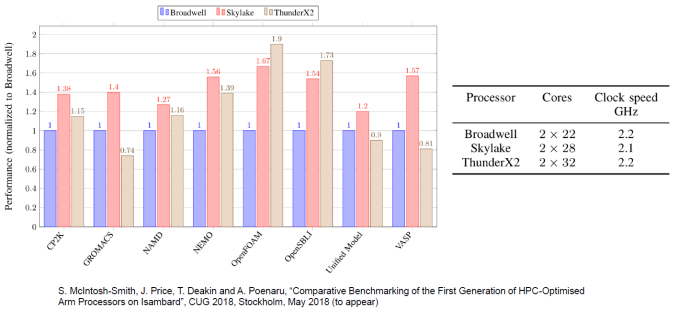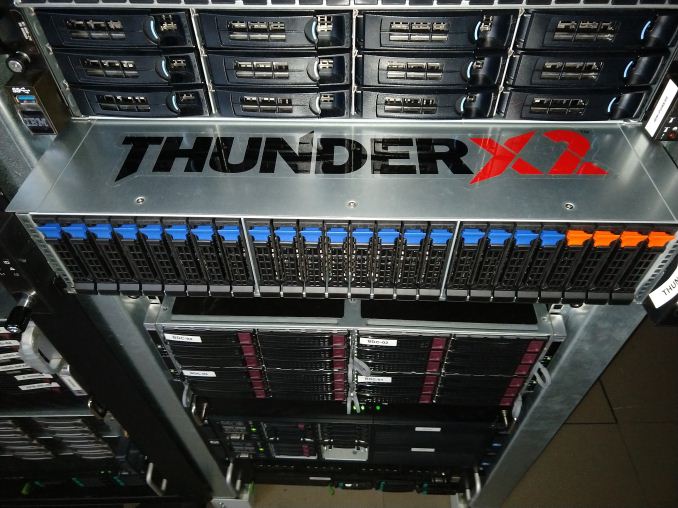Assessing Cavium's ThunderX2: The Arm Server Dream Realized At Last
by Johan De Gelas on May 23, 2018 9:00 AM EST- Posted in
- CPUs
- Arm
- Enterprise
- SoCs
- Enterprise CPUs
- ARMv8
- Cavium
- ThunderX
- ThunderX2
What We Can Conclude: So Far
Wrapping things up, our SPECInt analyses show that the ThunderX2 cores still has some weaknesses. Our first impression is that branch intensive code – especially in combination with regular L3-cache misses (high DRAM latency) – run quite a bit slower. So there will be corner cases where the ThunderX2 is not the best choice.
However, other than some niche markets, we are pretty confident that the ThunderX2 will be a solid performer. For example, the performance measurements done by our colleagues at the University of Bristol confirm our suspicion that memory intensive HPC workloads such as OpenFoam (CFD) and NAMD.run really well on the ThunderX2
From the early server software testing we have done so far, we can only be pleasantly surprised. The performance-per-dollar of the ThunderX2 in both Java Server (SPECJbb) and Big Data processing is – right now – by far the best in the server market. We have to retest AMD's EPYC server CPU and a Gold version of the current generation (Skylake) Xeon to be absolutely sure, but delivering 80-90% of the performance of the 8176 at one fourth of the cost is going to very hard to beat.
As an added benefit to Cavium and the ThunderX2, here in 2018 the Arm Linux ecosystem is now mature; specialized Linux kernels and other tools are no longer necessary. You just install Ubuntu Server, Red Hat, or Suse, and you can automate your deployments and software installation from the standard repositories. That is a massive improvement compared to what we experienced back when the ThunderX was launched. Back in 2016, simply installing from the regular Ubuntu repositories could cause problems.
So all in all, the ThunderX2 is a very potent contender. It might even be more dangerous to AMD's EPYC than to Intel's Skylake Xeon thanks to the fact that both Cavium and AMD are competing for much of the same pool of customers considering switching away from Intel. This is because the customers who have invested in expensive enterprise software (Oracle, SAP) are less sensitive to cost on the hardware side, so they are much less likely to change to a new hardware platform. And those people have been investing the past 5 years in Intel as it was the only option.
That in turn means that those who are more agile and cost sensitive, such as hosting and cloud providers, will now be able to choose an Arm server CPU alternative with an excellent performance-per-dollar ratio. And with HP, Cray, Pengiun computing, Gigabyte, Foxconn, and Inventec all offering systems based upon the ThunderX2, there isn't a shortage of quality vendors.
In short, the ThunderX2 is the first SoC that is able to compete with Intel and AMD in the general purpose server CPU market. And that is a pleasant surprise: at last, an Arm server solution that delivers!












97 Comments
View All Comments
Eris_Floralia - Wednesday, May 23, 2018 - link
The L2$ for SKX should be 1MB (256+768KiB), 16-way.Ryan Smith - Wednesday, May 23, 2018 - link
Right you are. Thanks!danjme - Wednesday, May 23, 2018 - link
Mental.Duncan Macdonald - Wednesday, May 23, 2018 - link
The CPU may be much cheaper than the equivalent Intel CPU - however on the price of a complete server there would be almost no difference as the vast majority of the price of a server is in other items (RAM, storage, network, software etc). To take a significant share, the performance needs to be better than Intel CPUs on both a per thread and a per socket basis. Potential users will look at this CPU - see that it is not faster than Intel on a per thread basis and is also not X86-64 compatible and turn away with a shrug. A price difference of under 5% for a complete server is not enough to justify the risks of going from x86-64 to ARM.BurntMyBacon - Thursday, May 24, 2018 - link
Perhaps you are correct and the lack of per thread performance will not allow Cavium to take a "significant' share of the market from Intel. However, at this point, getting even a small amount of market penetration in the server market is a significant achievement for an ARM vendor. This processor doesn't need to take a "significant" share from Intel to be successful. It just needs to establish a solid foothold. Given the data, I think it has a good chance of succeeding in that.The bigger question in my mind is how Intel will respond. They already have the ability to make a many lite core accelerator as demonstrated by the Xeon Phi line. Will they bring this tech to their CPU lineup, create a new accelerator based on this tech to handle applications that use many light threads, create a new many small core CPU based on Goldmont Plus (or Tremont), or will they consider the ARM threat insignificant enough to ignore.
boeush - Wednesday, May 23, 2018 - link
"(*) EPYC and Xeon E5 V4 are older results, run on Kernel 4.8 and a slightly older Java 1.8.0_131 instead of 1.8.0_161. Though we expect that the results would be very similar on kernel 4.13 and Java 1.8.0_161"What about Spectre/Meltdown mitigation patches? Were they in effect for 'older' results?
boeush - Wednesday, May 23, 2018 - link
To elaborate: if those numbers really are from July 2017, then they don't reflect true performance in a server context any longer (servers are where Spectre/Meltdown patches would be applied most.). Since the performance impact of Spectre/Meltdown is greatest on speculative execution and memory loads/prefetching, I'd guess those super-aggressive memory subsystem performance numbers, as well as single thread IPC advantages that Intel's CPUs claim in your benchmarks, are not really entirely applicable any longer.HStewart - Wednesday, May 23, 2018 - link
Spectre has been proved to effect other CPU's than Intel and even effects ARM and AMD.,Image on this article states that this CPU supports Fully Out of Order execution. So with my understanding of Spectre that this CPU also has issues.
To be honest I not sure how much the whole Spectre/Meltdown stuff is in this real world. It probably cause more harm in the computer industry than help.
Manch - Thursday, May 24, 2018 - link
Commentor: Blah Blah Blah Spectre?HStewart: Shill Shill Shill must defend Intel by any means...
lmcd - Thursday, May 24, 2018 - link
Commentor: reasonable position takenManch: *banned for unreasonable, offensive comments*